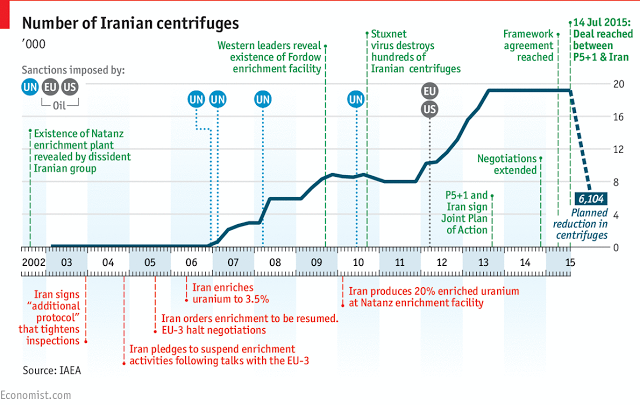The deal struck between Iran and the P5+1 (the permanent members of the UN Security Council and Germany) in Vienna in the early hours of July 14th was broadly in line with the parameters of the Lausanne accord of April 2nd referred to by Mr Obama. The framework understanding contained limitations on enrichment levels, centrifuge numbers (see chart) and types, and a cap on Iran’s stockpiles of low-enriched uranium. It also calls for the conversion of the Arak reactor to produce far less plutonium than the current design, and restricts research and development on more advanced centrifuges. Sunset dates for the various provisions, ranging from a decade to as long as 25 years were also established. In return, Iran will get relief from sanctions that have crippled its economy.
Highlights
* The agreement on inspections is a form of so-called “managed access”. Inspectors will not be able to conduct “anywhere, any time” visits. Instead, they will have to give grounds for their concerns about prohibited activities and give the Iranians an opportunity to address them before access is made mandatory by the joint commission. All this must take place within two weeks. Refusal by Iran to provide inspectors access that persisted for more than another week would be deemed a violation of the agreement and therefore subject to re-imposition of sanctions. [Two week process for Iran to try to hide and cheat inspections]
* Iran will be able to begin deployment of advanced enrichment centrifuges after the first 10 years of an agreement, but for 15 years it will have to keep its stockpile of low-enriched uranium below 300kg. After that, Iran will be able to develop the industrial-scale enrichment it seeks, but while its breakout time to a bomb will notionally diminish from the one year sought by the agreement, its obligations under the AP are perpetual, ensuring that even as its nuclear programme starts to expand again it will do so under conditions of far greater transparency than in the past. As long as future American presidents remain committed to preventing Iran from ever having a bomb and will use force if necessary to prevent it, deterrence should be maintained.
* On the question of the whether or not the arms embargo should be lifted, as the Iranians were demanding, a compromise has been thrashed out that appears to favour the tough line taken by American negotiators. The embargo, as it applies to the sale of offensive weapons to Iran, will remain in force for a further five years, while the ban on any technologies relating to ballistic missiles will stay in place for eight years. That means that the Russians, for example, will be able to go ahead with the sale of the S-300 air defence system, but presumably not of strike aircraft or tanks.
* A mechanism has also been established for dealing with possible Iranian violations of the deal that would allow sanctions to snap back automatically. (65 day process)
SOURCE -Economist

Brian Wang is a Futurist Thought Leader and a popular Science blogger with 1 million readers per month. His blog Nextbigfuture.com is ranked #1 Science News Blog. It covers many disruptive technology and trends including Space, Robotics, Artificial Intelligence, Medicine, Anti-aging Biotechnology, and Nanotechnology.
Known for identifying cutting edge technologies, he is currently a Co-Founder of a startup and fundraiser for high potential early-stage companies. He is the Head of Research for Allocations for deep technology investments and an Angel Investor at Space Angels.
A frequent speaker at corporations, he has been a TEDx speaker, a Singularity University speaker and guest at numerous interviews for radio and podcasts. He is open to public speaking and advising engagements.


